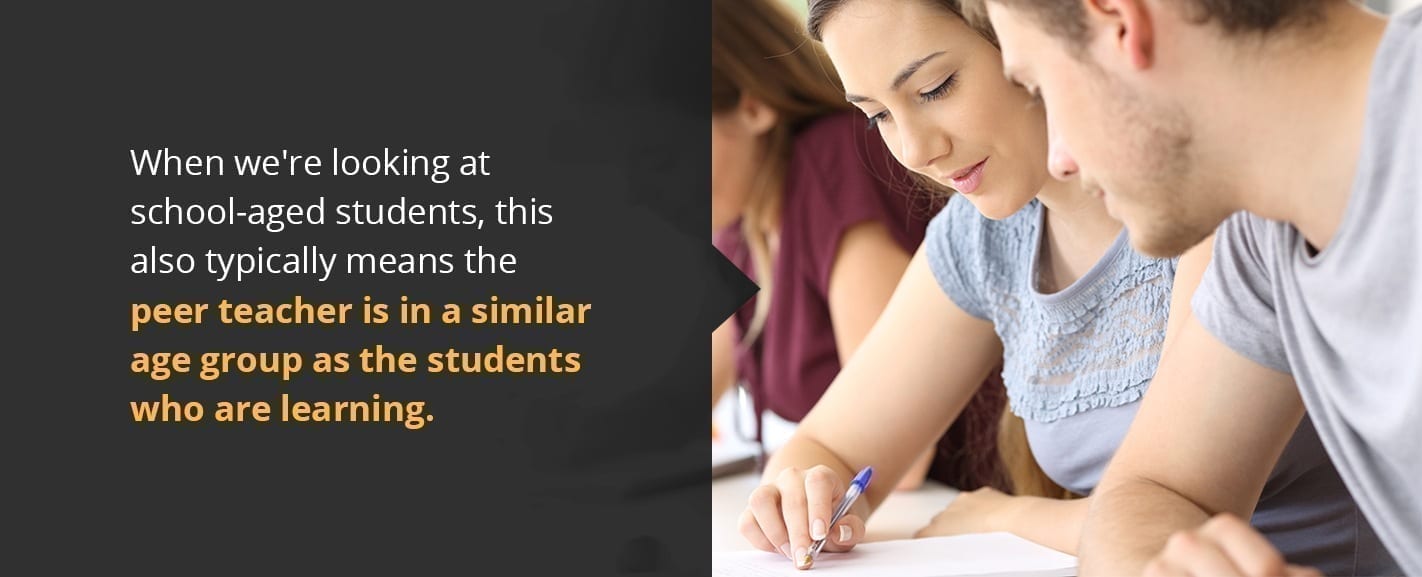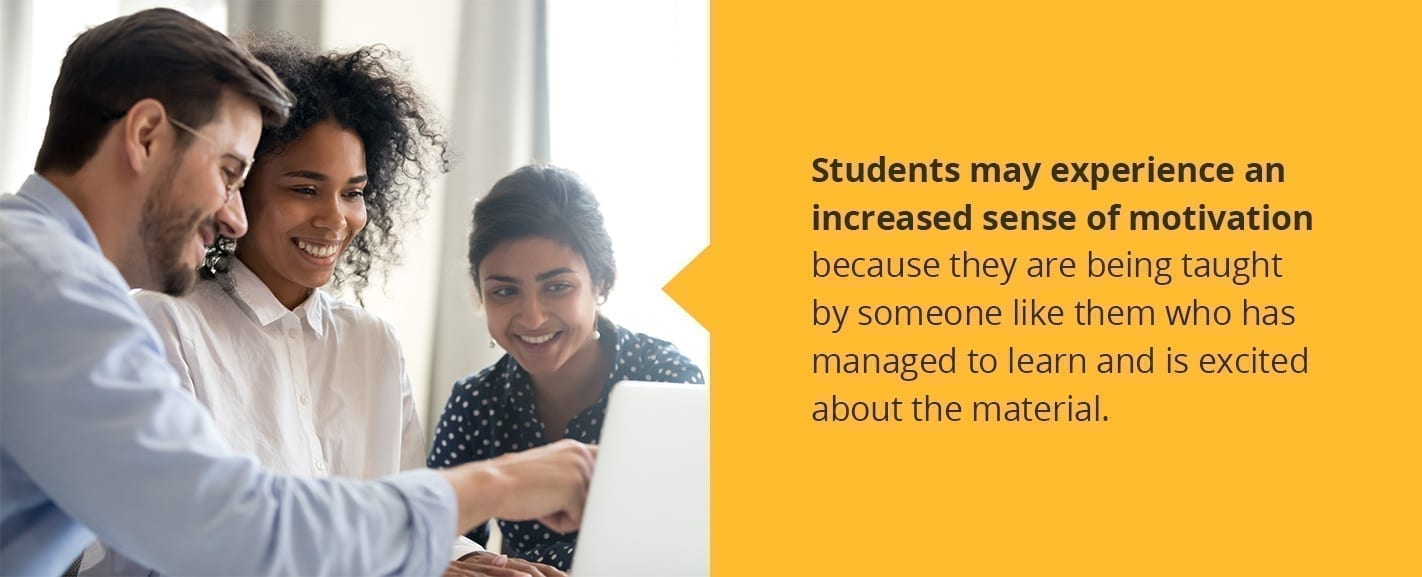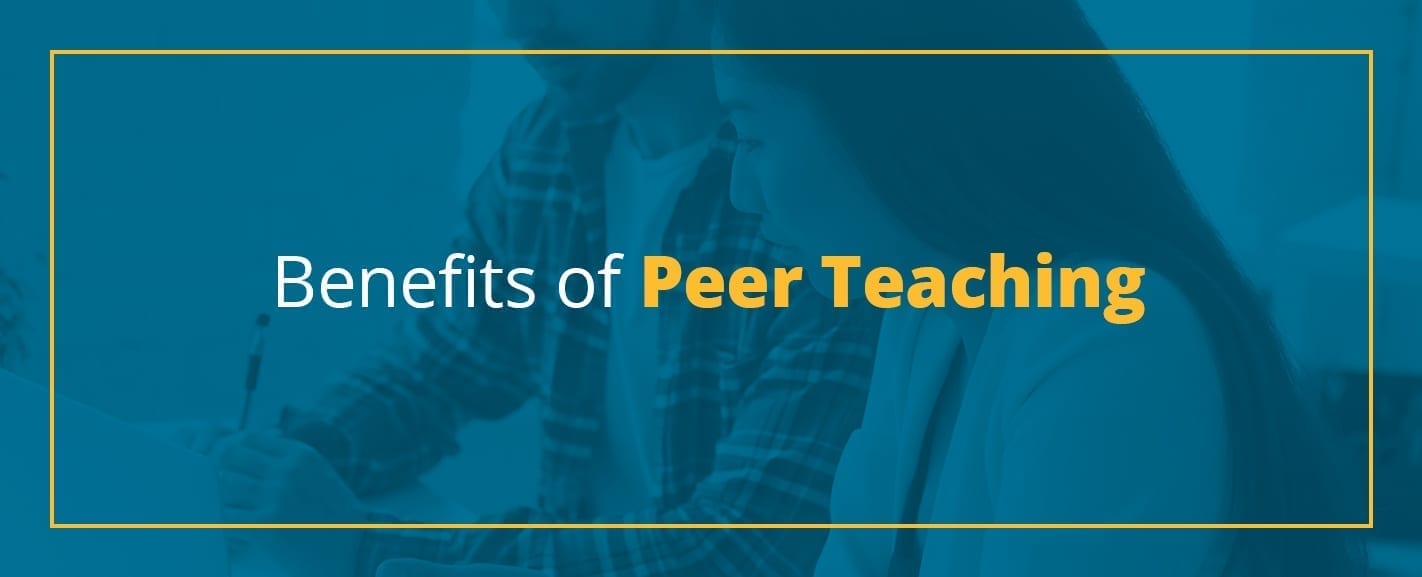If you’re familiar with how we teach at SummerTech, you know that we use peer teachers to instruct our classes. To some, being taught by a peer may be a foreign concept — although it’s likely that you’ve experienced peer teaching in informal settings or on smaller scales. In fact, peer teaching has become increasingly revered as a pedagogical strategy and is becoming common for good reason. Peer teaching offers some important benefits for learners and instructors alike.
Being taught by a peer can break down barriers that may affect some students and can create a more engaging learning experience. Peer teachers can also benefit from the process. We’re going to explain what peer teaching is, how it works, and what the advantages are of this educational model.
What Is Peer Teaching?

The traditional classroom model for middle and high school students involves an adult instructor teaching a group of young people. These teachers have a mastery-level understanding of the material and, in most cases, they originally learned the material long in the past. There are clear distinctions between teachers and students in these instructional settings. Teachers are at an entirely different station in life and possess the authority to lead and teach their students.
This model works well in many instances, but it’s certainly not the only model for teaching and may not be the best option in some cases. An alternative model for teaching puts students’ peers into the instructor role. By “peers,” we mean students who are in a similar position in life. In other words, neither has authority over the other.
When we’re looking at school-aged students, this also typically means the peer teacher is in a similar age group as the students who are learning. While these students may be similar in age and education level in general, when it comes to the subject at hand, the peer teacher has greater understanding and experience than their peer students.
These peer teachers may be especially talented in a certain area and have, therefore, excelled and progressed more rapidly than their peers. Or, perhaps they have taken classes their peers simply haven’t. Peer teaching can work on small and large scales. When peer teachers are the sole instructors in a class, they can work under the administrative guidance of adults.
Examples of Peer Learning
If you’ve never seen peer teaching in action, it can help to consider some examples of what students teaching students can look like. Let’s take a look at some examples of peer learning:
- A music teacher has a student who has had private trombone lessons give a special lesson on the trombone for their peers.
- A college senior partners with a faculty member to lead a freshmen-year experience course for first-year college students.
- An ESL student helps teach their English-speaking peers how to speak their native language.
- High school students who have learned how to code through a summer course helping their peers learn to code in groups.
- A student whose reading level is higher than their peers leads a discussion group over an assigned reading for English class.
- A fourth-year medical student leads a clinical skills laboratory for other medical students.
These are just a handful of examples of the forms peer teaching can take. Peer teaching can use a variety of formats, from discussion groups facilitated by student leaders to classes entirely taught by peer teachers.
How Kids Learn Through Peer Teaching
When peer teaching is used in a classroom, kids can enjoy an effective and engaging learning experience. It’s important to note that all kids are different and learn in different ways, so they may have different responses to peer teaching.
In general, kids can learn from their peers in a similar way as they learn from adult teachers. Just as adult teachers transfer the information they know to students, peer teachers can also transfer what they know. The difference isn’t so much in how they are taught as in who is doing the teaching and the dynamic that creates. Having a peer as their instructor can foster a different type of dynamic compared to a traditional teacher-student relationship.
Some students feel more comfortable learning from a peer and maybe more engaged in their learning. We’ll explore the potential benefits of peer learning in the next section.
What Are the Advantages of Peer Learning?
Peer teaching/learning has become increasingly popular in many instructional settings in recent decades because it has demonstrated several valuable benefits.
For students, peer learning can lead to improved attitudes and a more personalized, engaging, and collaborative learning experience, all of which can lead to higher achievement. For peer teachers, the experience can deepen their understanding of the subject and impart confidence. Let’s take a closer look at the benefits of peer teaching.
1. It Can Improve Students’ Attitudes Toward Learning

One of the benefits of peer teaching is that it can have a positive effect on students’ attitudes about what they’re learning and the learning process in general. According to the International Encyclopedia of Education, research has shown that collaboration among peers in a learning environment can enhance students’ socioemotional development. This includes improving their concept of self and having a better attitude toward learning.
Being taught by a peer can break down barriers that might exist for some otherwise disengaged students. For example, having a peer teacher may make some students feel more comfortable and more willing to ask for the help they need. Students may also experience an increased sense of motivation because they are being taught by someone like them who has managed to learn and is excited about the material. In other words, they have a success story right in front of them to inspire them to achieve the same results.
One study found that peer learners valued the fact that their peer teacher had recently learned the materials and could relate to their experience of learning the material for the first time. Students who may feel a sense of disconnect while learning from a teacher who studied the material long ago are likely to appreciate learning from a more relatable peer.
2. It Can Foster a More Personalized Learning Experience
There is convincing evidence to show that a lower student-to-teacher ratio is beneficial for both teachers and students — especially students in the six to 14 age bracket. It’s not hard to see how having more one-on-one attention from a teacher can help individual students excel. Peer teaching can be done in larger groups where peer teachers are greatly outnumbered by peer learners. This model would typically take place in a college lecture scenario.
That said, peer teaching can lend itself well to lower student-to-teacher ratios, where either a single student teacher is leading a small group of students or multiple student teachers are helping to lead a larger class. With this model, peer instructors can check on students individually, answer questions, and assist each student in the way they need. This may mean explaining the material in different ways to different students or walking students through a process individually.
This type of personalized learning or peer tutoring can help students progress in a subject more quickly and develop a stronger handle on the material than they might have in a large group setting with a single teacher.
3. It Engages Students Through Cooperative Learning
Cooperative learning is a type of learning that is distinct from two other learning structures: individualized and competitive learning. In the case of cooperative learning, students work together, each contributing what they can to help improve their understanding of a subject. Typically, cooperative learning involves having students of different ability levels work together in groups.
A peer-to-peer learning dynamic lends itself naturally to a collaborative classroom environment. Cooperative learning is inherently student-centered, so it makes sense that one of the best ways to create an engaging and cooperative learning experience is in a classroom for students and led by students.
This structure of learning actively engages students in the learning process because it encourages each student to feel more ownership over their education. Research shows that cooperative learning can contribute to enhanced productivity and achievement and more supportive relationships between peers, along with improvements in self-esteem and overall mental and emotional well-being. When students feel like they’re on the same team and working toward a common goal, exciting things can happen in a classroom.
4. It Can Lead to Higher Academic Achievement

Another reason some educational programs choose to implement student teaching is because it may lead to higher academic achievement for students. Research on how peer teaching impacts student achievement is not entirely clear, mostly because research on this direct connection is limited and because there are so many factors that can affect a student’s level of achievement.
That said, when students are more engaged in the learning process, more motivated, and have received more individualized assistance, it’s easy to see why they are likely to succeed. For some students, being more engaged by a peer teacher can make all the difference in helping them develop a strong handle on the material and feel the motivation they need to do their best.
Higher achievement is especially likely if a peer learning model prioritizes small class sizes or low student-to-teacher ratios. This helps to ensure that each student receives individualized help. More individualized instruction also makes it more likely for students with a natural talent to excel beyond the standard learning goals of the course.
5. It Can Help Peer Teachers Gain Confidence and Sharpen Their Skills
It’s also important to note that peer teaching is not a one-way exchange. Peer teachers can also experience benefits from engaging in the peer learning process. If you’ve ever taught a concept or skill to a friend, you may have noticed how this act of teaching helped you brush up on information or sharpen your skills.
There is a wealth of research to show that teaching something is an effective way to enhance your own understanding of the material. This means student teachers can sharpen their knowledge through the process of transferring their skills to peers. As they prepare lessons, answer questions, provide demonstrations, and more, peer leaders can come away with a deeper understanding of the material. They may even learn something new from another peer teacher or a peer student.
Research also shows other benefits for peer teachers. Developing lessons and working in an instructor role can help them grow in creativity, independence, and self-confidence, among other things. Some peer teachers may have their excitement and inspiration surrounding a certain content area or skill revitalized by bringing it alive for other students.
How SummerTech Incorporates Peer Teaching at Camp
At SummerTech, we believe in the power of peer teaching. All the benefits we just looked at make it clear that peer teaching, if executed well, can have a significant and positive impact on students. The peer teaching model lends itself especially well to technological skills, where peers are likely to respect the fresh, cutting-edge knowledge of their recently trained peers.
All of our instructors at SummerTech are students themselves, either in high school or college, who have attended SummerTech themselves and are now equipped to teach their peers. These peer teachers bring their creativity and passion along with their expertise into the classroom to pass on their skills and serve as role models for their peers. Campers range in age from 10 to 17 years old, so they are often a bit younger than their instructors. But as fellow students, they can experience a thriving peer relationship.
We mentioned the importance of small student-to-teacher ratios, and we prioritize that in all of our classes. At most, our classes have three students for every teacher. This way, students get the one-on-one attention they need to succeed and can work at a more individualized pace.
Using the peer teaching model in a camp setting can also amp up many of the potential benefits of peer teaching. A camp setting can encourage kids to have fun and feel more motivated and actively engaged in their learning. Taking on new skills with peers, like learning to code, feels distinctly different from a typical school class, and campers are likely to conclude their experience with a great deal of confidence and passion in the subject area and maybe even a desire to return as a peer teacher in the future.
Experience the Benefits of Peer Teaching at SummerTech

SummerTech combines the fun of summer camp with a practical education in technical skills like programming, animation, web development, and more.
Our learning opportunities are unique and unrivaled compared to other educational programs teaching STEM subjects to youth. Students ages 10 to 17 are welcome to attend one of our summer camps, either as a commuting or an overnight camper. Parents and students have the freedom to tailor the experience to exactly what they want, so you can attend for as many weeks as you prefer.
At SummerTech, students can enjoy a safe and supportive environment where they are encouraged to go after their dreams and develop new skills that can help them launch into future educational programs or careers. Campers will make new friends and benefit from learning from passionate and knowledgeable peers. Learn more about our courses and register online today.


